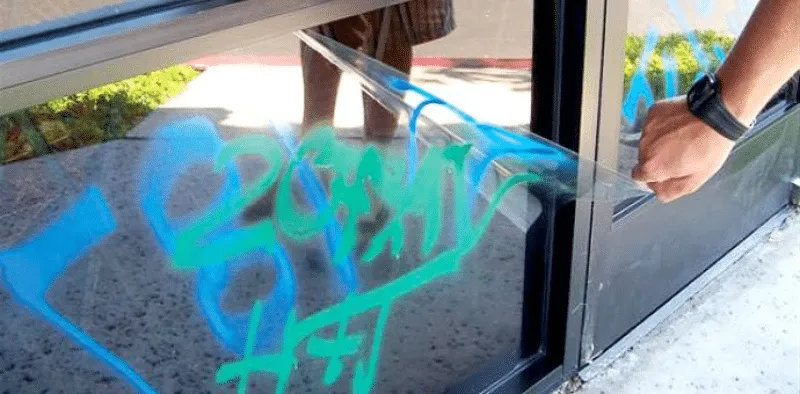No products in the cart.
Return To ShopAnti-Graffiti UV Film 72″ Wide Protects Glass | Stainless Steel | Order 1′ Increment | 4 mil
Our Solyx Brand Anti-Graffiti Clear Films are sacrificial wipe-clean, UV resistant protective films providing a tough, invisible layer between vandals and interior and exterior glass windows and mirrors, as well as other non-porous surfaces like stainless steel and marble (suggest testing on the “other” surfaces for proper adhesion).
This 4 mil, polyester, exterior film has a removable adhesive system and a scratch resistant coating. When vandalized, the film is easily removed and replaced for clean-up – reducing property damage and maintaining aesthetics.
A tough polyester surface hard coat enables quick cleaning of spray paint and pen attacks. It is the efficient alternative to costly, time-consuming glass replacement.
The Anti-Graffiti Clear Film when used on glass blocks up to 98% of UV rays coming through a glass window, making it an excellent way to protect against damage to sensitive areas on the inside of stores and other areas. Yet the Unoticeable Clear Film transmits 89% of visible light and so does not impact lighting in a store. It also is not easily noticed by taggers.
Before using a liquid graffiti remover to remove graffiti tagging, always test the remover in a small inconspicuous spot to make sure it won’t stain the graffiti film. Like all graffiti removal efforts, use the least aggressive remover that works. In some cases may have to replace the film which as a sacrificial product is designed to protect the underlying surface from damage.
Order only what you need! Our Anti-Graffiti Film comes in 72″ wide rolls ordered in 1′ increments (minimum order 10′ long roll). For narrower requirements see our 4 mil x 60″ wide rolls.
For large projects requiring longer 100′ rolls, more variety in roll width from 36″ to 72″ with both a 4 mil and heavy duty 6 mil option, use our Anti-Graffiti Large Project Film. For large projects on acrylic and PMMA surfaces such as outdoor transit shelters, use this link Acrylic PMMA Project Film
For Cleaning all Window Films see our SimGlas Window Film Cleaner & Polish that will Clean – Protect – Beautify (non-toxic and alcohol & ammonia free)
WHERE IS ANTI-GRAFFITI FILM USED?
- Public Transport buses, subway cars etc, commercial store front windows, shopping malls, restrooms, lobbies and elevators are all prime targets for abuse
WHY ANTI-GRAFFITI UV RESISTANT FILM?
- Graffiti Paint and Marker Protection With a Tough Invisible Film For a variety of smooth, dense surfaces
- Great for Glass Windows, Doors & Mirrors as well as Stainless Steel, Marble and other non-porous smooth surfaces
- 72″ Wide Roll. Order only what you need in 1′ increments (minimum order 10′ long)
- Interior and Exterior
- Wipe-clean coating allows quick removal of most graffiti paint attacks
- Hassle Free & Quick-release adhesive for speedier film removal and replacement
- Lets 89% of Visible Light Through
- Blocks 98% of UV Radiation
- Tensile Strength 30,000 lbs/square inch
- 4 mil thick
- Order in 1′ Increments (minimum order 10′ Long roll)
- Class A Fire Rated per ASTM E84 as defined in NFPA 101, Life Safety Code®

